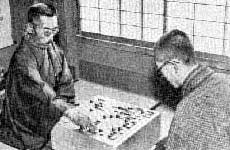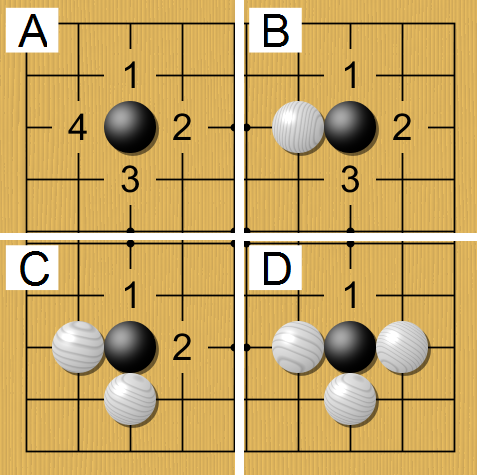|
Nobuaki Maeda
Maeda Nobuaki was a Japanese professional 9 dan go player, a disciple of Honinbo Shusai, and a member of the Nihon Ki-in, the main organizational body for go in Japan. His own disciples were Norio Kudo, Yusuke Oeda, Shioiri Itsuzo, Nagahara Yoshiaki, and Morikawa Masao. Maeda reached the highest professional rank, 9 dan, in 1963, but never achieved the consistent record of tournament success that marks the truly elite player. Maeda is famous today principally for his series of tsume-go (problem) collections, which gained him the honorary nickname "god of tsume-go." It is said that he composed a problem a day for 40 years. Many of these problems are considered especially beautiful, ingenious, or instructive. Maeda is also remembered for his presumed role in one of the most sensational and controversial games of the 20th century: the 1933 challenge game between his teacher, Honinbo Shusai, and the Chinese prodigy Go Seigen Wu Quan (), courtesy name Wu Qingyuan ()His cour ... [...More Info...] [...Related Items...] OR: [Wikipedia] [Google] [Baidu] |
Dan Rank
The ranking system is used by many Japanese, Okinawan, Korean, and other martial art organizations to indicate the level of a person's ability within a given system. Used as a ranking system to quantify skill level in a specific domain, it was originally used at a Go school during the Edo period. It is now also used in most modern Japanese fine and martial arts. Martial arts writer Takao Nakaya claims that this dan system was first applied to martial arts in Japan by Kanō Jigorō (1860–1938), the founder of judo, in 1883, and later introduced to other East Asian countries. In the modern Japanese martial arts, holders of dan ranks often wear a black belt; those of higher rank may also wear either red-and-white or red belts depending on the style. Dan ranks are also given for strategic board games such as Go, Japanese chess ('' shōgi''), and renju, as well as for other arts such as the tea ceremony (''sadō'' or ''chadō''), flower arrangement (''ikebana''), Japanese call ... [...More Info...] [...Related Items...] OR: [Wikipedia] [Google] [Baidu] |
Go (game)
Go is an abstract strategy board game for two players in which the aim is to surround more territory than the opponent. The game was invented in China more than 2,500 years ago and is believed to be the oldest board game continuously played to the present day. A 2016 survey by the International Go Federation's 75 member nations found that there are over 46 million people worldwide who know how to play Go and over 20 million current players, the majority of whom live in East Asia. The playing pieces are called stones. One player uses the white stones and the other, black. The players take turns placing the stones on the vacant intersections (''points'') of a board. Once placed on the board, stones may not be moved, but stones are removed from the board if the stone (or group of stones) is surrounded by opposing stones on all orthogonally adjacent points, in which case the stone or group is ''captured''. The game proceeds until neither player wishes to make another move. Wh ... [...More Info...] [...Related Items...] OR: [Wikipedia] [Google] [Baidu] |
Go Players
This article gives an overview of well-known professional and amateur players of the board game Go throughout the ages. The page has been divided into sections based on the era in which the Go players played and the country in which they played. As this was not necessarily their country of birth, a flag of that country precedes every player's name. For a complete list of player articles, see :Go players. The important dates that this separation is based on are: * The establishment of the Four go houses at the start of the Tokugawa Shogunate. * The demise of the houses in the Meiji Period (end 19th century) followed by their replacement by the Nihon Kiin in 1924. * The start of international tournament Go in 1989 A Japanese census on Go players performed in 2002 estimates that over 24 million people worldwide play Go, most of whom live in Asia. Most of the players listed on this article are professionals, though some top level amateurs have been included. Players famous for ... [...More Info...] [...Related Items...] OR: [Wikipedia] [Google] [Baidu] |
Hon'inbō Shūsai
is the professional name of Hoju Tamura, also known as , who was a Japanese professional Go player. Biography Shusai was born in Shiba, Tokyo, son of Tamura Yasunaga, a retainer of the ''shōgun''. He learned go at age 10 and joined the Hoensha in 1883, then under the leadership of Murase Shūho. He was made ''shodan'' at age 13. At age 18, he attained the rank of 2nd ''dan'' (the lower professional ranks cannot be assumed to correspond to modern ones). He then broke with the game for a time, tried to go into business on his own account, and ended up in a Buddhist retreat in Chiba Prefecture. After more than a year out of the game, he set up his own go salon in Roppongi.''Go Monthly Review'', 1963/11 p.68 He was then helped by Kim Ok-gyun, a Korean then resident in Japan, who used his contacts to secure Tamura an introduction to Hon'inbō Shūei. He was re-ranked as 4th ''dan'' in 1892 and proceeded up the ranks from there. He engaged in a number of high-profile matches. H ... [...More Info...] [...Related Items...] OR: [Wikipedia] [Google] [Baidu] |
Nihon Ki-in
The Nihon Ki-in (), also known as the Japan Go Association, is the main organizational body for Go in Japan, overseeing Japan's professional system and issuing diplomas for amateur dan rankings. It is based in Tokyo. The other major Go association in Japan is Kansai Ki-in. Its innovations include the Oteai system of promotion, time limits in professional games, and the introduction of issuing diplomas to strong amateur players, to affirm their ranks. History The Nihon Ki-in was established in July 1924. The first president of the Nihon Ki-in was Makino Nobuaki, a great Go patron himself, with Okura Kishichiro serving as vice president. The vast majority of pros at the time joined the fledgling organization, excepting the Inoue faction in Osaka and Nozawa Chikucho. A brief splinter group called Kiseisha was created soon after the Nihon Ki-in was formed, but most of the players involved had returned to the Nihon Ki-in within a couple of years. Then in 1950, its western branch spl ... [...More Info...] [...Related Items...] OR: [Wikipedia] [Google] [Baidu] |
Norio Kudo
is a professional Go (board game), Go Go players, player. Biography Kudo turned professional in 1955 and was promoted to 9 dan in 1976. Although he did not win many tournaments, he was known for teaching Go to many people, even if they were just starting to learn, or were about to turn 1 dan. He succeeded the late Masao Kato as president of the International Go Federation in 2005. Promotion record Titles & runners-up External linksGoBase Profile (Japanese) 1940 births Japanese Go players Living people People from Hirosaki {{Japan-Go-bio-stub ... [...More Info...] [...Related Items...] OR: [Wikipedia] [Google] [Baidu] |
Yusuke Oeda
was a 9-dan professional Go player, affiliated with the Nihon Ki-in, who lived in Japan. He was a student of Nobuaki Maeda. Promotion record This is a list of pupils who have been taught by Yusuke Oeda in the game of Go. *Ryu Shikun (from 1986) *Kana Mannami * Yasutoshi Yasuda (from 1977) * Morito Oubuchi (from 1983) *Yo Kagen ''Yo'' is a slang interjection, commonly associated with North American English. It was popularized by the Italian-American community in Philadelphia, Pennsylvania, in the 1940s. Although often used as a greeting and often deployed at the ... (from 1982) * Michael Redmond (from 1977) * Yasuhiko Onda (from 1982) * Yo Kaei (from 1984) * Hideichiro Iguchi (from 1977) * Yoshifumi Endo * Zenki Han * Ryutaro Miyazaki * Shimako Miyazaki * Masanori Kurotaki * Masaki Kurotaki * Gensho Shimoji * David Mechner References External links GoBase profile Sensei's Library profile 1935 births Japanese Go players 2010 deaths Sportspeople from Tokyo ... [...More Info...] [...Related Items...] OR: [Wikipedia] [Google] [Baidu] |
Morikawa Masao
Morikawa (most commonly ) is a Japanese surname. Notable people with the surname include: *Aizō Morikawa (1878–1949), photographer *Collin Morikawa (born 1997), American golfer *, Japanese tea master *, Japanese film director *Miho Morikawa (born 1968), singer and model *, Japanese footballer *Toshiyuki Morikawa (born 1967), voice actor *Yōichirō Morikawa is a Japanese Independent film director, screenwriter, actor and calligrapher. He gained media attention when he was arrested and charged on suspicion of paying a 17-year-old girl for sexual services in March 2006. "児童買春:映画監督 ... (born 1979), film director, screenwriter and actor *, Japanese racewalker *, Japanese footballer References {{surname Japanese-language surnames ... [...More Info...] [...Related Items...] OR: [Wikipedia] [Google] [Baidu] |
Go (board Game)
Go is an abstract strategy board game for two players in which the aim is to surround more territory than the opponent. The game was invented in China more than 2,500 years ago and is believed to be the oldest board game continuously played to the present day. A 2016 survey by the International Go Federation's 75 member nations found that there are over 46 million people worldwide who know how to play Go and over 20 million current players, the majority of whom live in East Asia. The playing pieces are called stones. One player uses the white stones and the other, black. The players take turns placing the stones on the vacant intersections (''points'') of a board. Once placed on the board, stones may not be moved, but stones are removed from the board if the stone (or group of stones) is surrounded by opposing stones on all orthogonally adjacent points, in which case the stone or group is ''captured''. The game proceeds until neither player wishes to make another move. When ... [...More Info...] [...Related Items...] OR: [Wikipedia] [Google] [Baidu] |
Go Seigen
Wu Quan (), courtesy name Wu Qingyuan ()His courtesy name was created based on his real name (''Quan'' means "spring, fountain" and ''Qing Yuan'' means "clear and pure source of water"). (June 12, 1914 – November 30, 2014), better known by the Japanese pronunciation of his courtesy name, , was a Chinese-born Japanese master of the game of Go. He is considered by many players to have been the greatest Go player in the 20th century. Biography Born on June 12, 1914, in Minhou County, Fujian Province, southeast China, Go Seigen did not start learning Go until he was nine, a relatively late age for a professional (Honinbo Dosaku first learned go at seven and Honinbo Shusaku before he was six). His father, who had taken go lessons from Honinbo Shuho while studying in Japan, was responsible for introducing him to the game. Go Seigen quickly excelled and soon became known as a Go After days and nights, the shape of his left index finger changed, bending backwards. At that time, p ... [...More Info...] [...Related Items...] OR: [Wikipedia] [Google] [Baidu] |



_5.jpg)

